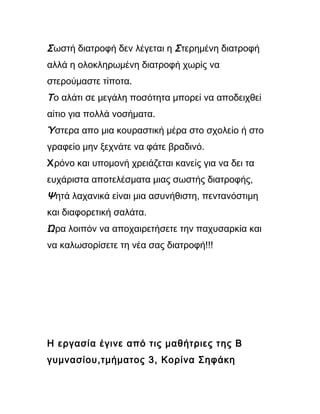Improving The Accuracy Of Automated Visual Inspection For Lyophilized Vials

Table of Contents
Optimizing Image Acquisition for Enhanced Accuracy
High-quality images are the foundation of accurate automated visual inspection. Suboptimal image acquisition can lead to missed defects and false positives, compromising the integrity of the entire process. Several factors contribute to achieving optimal image acquisition for lyophilized vials.
Lighting and Illumination Techniques
Consistent and appropriate lighting is crucial for minimizing shadows and reflections that can obscure defects. The type of lighting employed significantly impacts image quality.
- Coaxial lighting: Illuminates the vial from directly above, minimizing shadows but potentially highlighting surface imperfections more prominently.
- Diffuse lighting: Provides even illumination, reducing glare but potentially masking subtle defects.
- Ring lighting: Offers a combination of coaxial and diffuse lighting, providing a balance between shadow reduction and defect visibility.
The intensity and angle of the light source must be carefully controlled to achieve optimal image contrast and clarity. The color and material of the vial itself also influence the choice of lighting technique. Darker vials may require higher intensity lighting, while transparent vials might benefit from diffuse lighting to minimize glare.
Camera Selection and Calibration
Selecting the right camera and ensuring its precise calibration are essential for capturing clear and detailed images.
- Sensor Types: CMOS (Complementary Metal-Oxide-Semiconductor) and CCD (Charge-Coupled Device) sensors are common choices. CMOS sensors generally offer faster frame rates and lower power consumption, while CCD sensors often provide better image quality at higher costs.
- Resolution Requirements: High-resolution cameras are necessary to capture fine details, allowing for the detection of even small defects. The required resolution will depend on the size of the defects being inspected and the size of the vials.
- Calibration Procedures: Regular calibration is crucial to maintain the camera's accuracy. Calibration procedures involve adjusting the camera's settings to ensure accurate color representation and geometric distortion correction. The frequency of calibration should be determined based on the system's use and environmental factors. Lens selection is equally important; the correct lens ensures optimal focus and minimizes distortion.
Image Preprocessing Techniques
Before defect detection, image preprocessing techniques significantly enhance image quality. These techniques help to improve the accuracy of the automated visual inspection process by filtering out noise and artifacts.
- Noise Reduction: Algorithms can filter out random noise that can interfere with defect detection.
- Image Sharpening: Techniques like unsharp masking enhance the edges of defects, making them easier to detect.
- Background Correction: Algorithms can correct for variations in background illumination, improving the contrast between the vial and its background.
- Handling Orientation Variations: Automated systems must handle variations in vial orientation during the inspection process. Image preprocessing techniques can correct for rotation and tilt, ensuring consistent defect detection.
Advanced Algorithms for Defect Detection
Traditional image processing methods are often insufficient for detecting subtle defects in lyophilized vials. Advanced algorithms, driven by artificial intelligence (AI) and machine learning (ML), offer significantly improved accuracy and speed.
Machine Learning and Deep Learning Approaches
AI and ML offer transformative advancements over traditional methods for defect detection.
- Convolutional Neural Networks (CNNs): CNNs excel at identifying complex patterns in images, making them ideal for detecting subtle defects. They require extensive training data to achieve optimal performance.
- Support Vector Machines (SVMs): SVMs are effective for classifying defects based on extracted features, particularly when dealing with smaller datasets.
- Training Data Requirements: The accuracy of AI/ML algorithms depends heavily on the quality and quantity of training data. A large, diverse dataset representing various types of defects is necessary to achieve high accuracy. The advantages of AI/ML include increased speed and accuracy compared to traditional methods, while limitations might include the need for extensive training data and computational resources.
Defect Classification and Severity Assessment
Beyond simple defect detection, automated systems should classify defects and assess their severity.
- Image Segmentation: This process isolates defects from the background, facilitating accurate classification.
- Feature Extraction: Features like size, shape, and texture are extracted from segmented defects to inform classification.
- Classification Models: Machine learning models are trained to classify defects into different categories (e.g., cracks, particulate matter, delamination).
- Quality Control Metrics: The severity of defects is assessed using predefined quality control metrics, allowing for automated rejection of substandard vials.
Improving System Validation and Calibration
Rigorous validation and regular calibration are essential to maintain the accuracy and reliability of automated visual inspection systems.
Establishing Robust Validation Protocols
Validation ensures the system meets accuracy and reliability standards.
- Comparison with Manual Inspection: The automated system's results can be compared with those obtained through manual inspection to assess accuracy.
- Certified Reference Standards: Using vials with known defects allows for precise evaluation of the system's performance.
- Validation Frequency: The frequency of validation depends on factors such as system usage, environmental conditions, and regulatory requirements. Comprehensive documentation is crucial for meeting regulatory compliance standards.
Regular System Calibration and Maintenance
Regular calibration and maintenance are vital for long-term system performance.
- Calibration Procedures: Detailed calibration procedures should be followed to maintain accuracy and precision. This includes adjusting light sources, camera settings, and algorithms.
- Maintenance Schedule: A proactive maintenance schedule helps prevent system malfunctions and errors.
- Environmental Factors: Temperature and humidity fluctuations can impact system performance; controlled environmental conditions are ideal.
- Trained Personnel: Only trained personnel should perform calibration and maintenance to ensure the accuracy and reliability of the process.
Conclusion: Achieving Higher Accuracy in Automated Visual Inspection of Lyophilized Vials
Optimizing image acquisition through careful lighting, camera selection, and image preprocessing, combined with advanced algorithms like those found in AI and ML, and rigorous validation protocols, significantly enhances the accuracy of automated visual inspection systems for lyophilized vials. These improvements are crucial for maintaining product quality, ensuring regulatory compliance, and boosting efficiency in pharmaceutical manufacturing. Implement these advanced techniques to revolutionize your automated visual inspection of lyophilized vials and achieve unparalleled accuracy.

Featured Posts
-
 Uruguay Vs Colombia Sub 20 Sigue El Partido En Vivo Online
May 11, 2025
Uruguay Vs Colombia Sub 20 Sigue El Partido En Vivo Online
May 11, 2025 -
 Tzesika Simpson I Fonitiki Tis Texniki Kai I Asynithisti Diatrofi
May 11, 2025
Tzesika Simpson I Fonitiki Tis Texniki Kai I Asynithisti Diatrofi
May 11, 2025 -
 Ufc 315 Fight Card What To Expect Tonight
May 11, 2025
Ufc 315 Fight Card What To Expect Tonight
May 11, 2025 -
 Shane Lowrys Viral Video A Look At The Divided American Fan Reaction
May 11, 2025
Shane Lowrys Viral Video A Look At The Divided American Fan Reaction
May 11, 2025 -
 Apples Ecosystem And Googles Dominance A Complex Relationship
May 11, 2025
Apples Ecosystem And Googles Dominance A Complex Relationship
May 11, 2025
